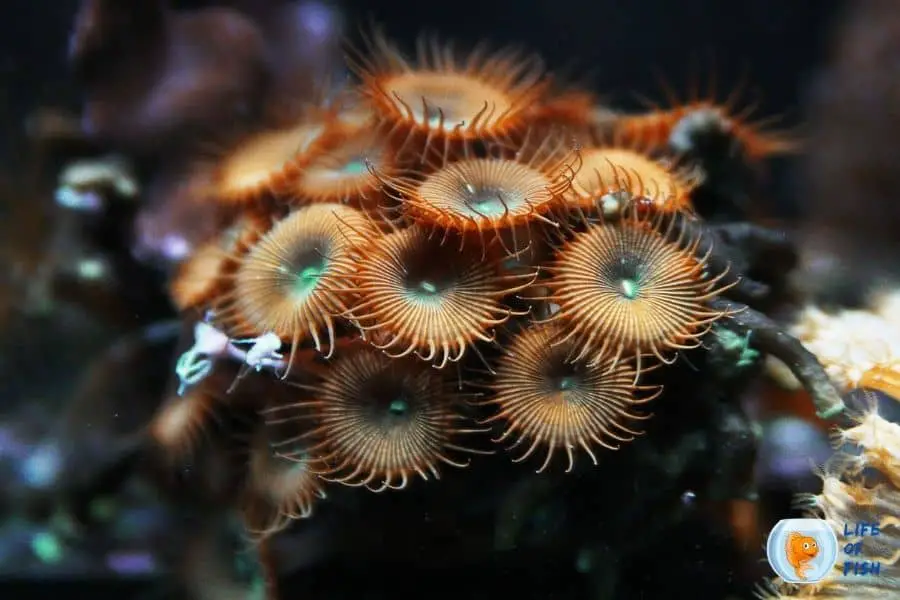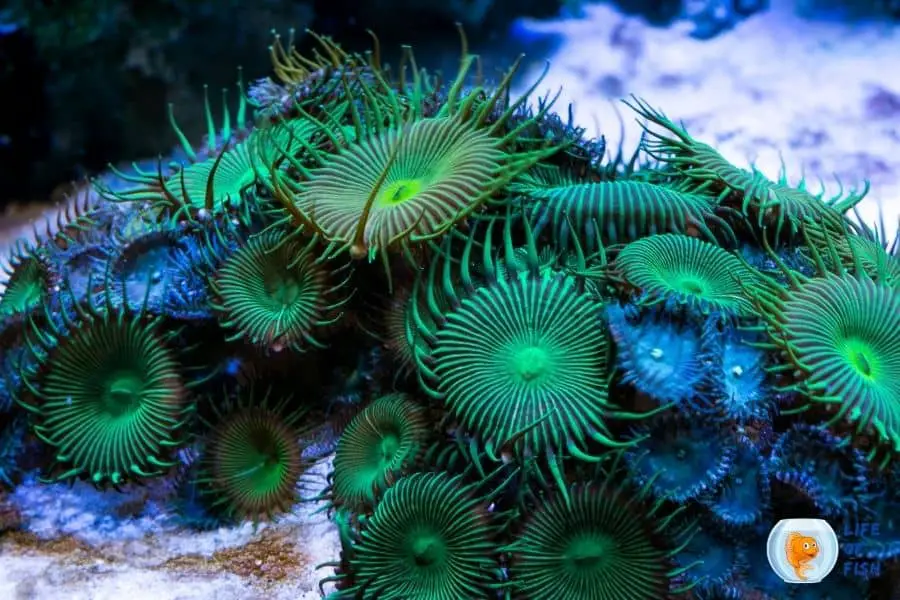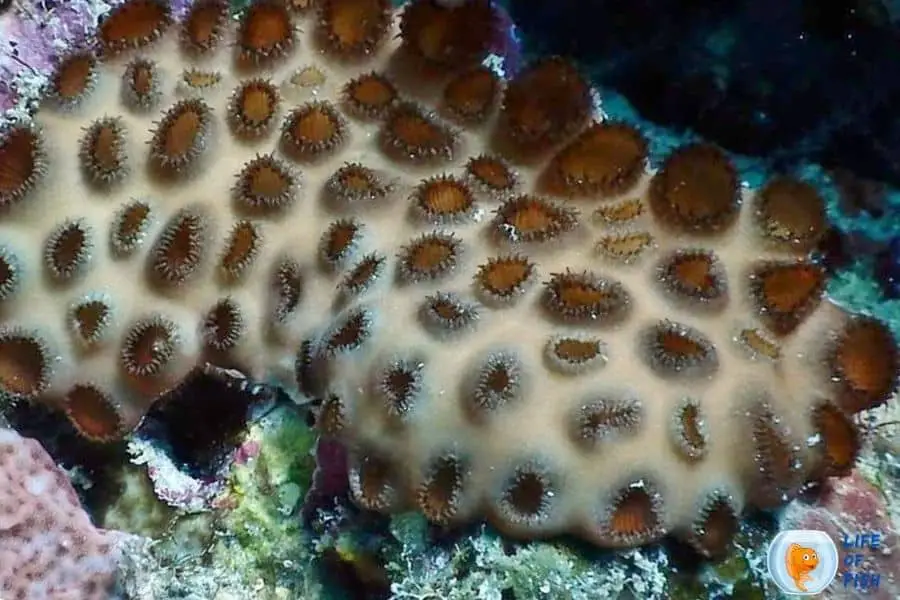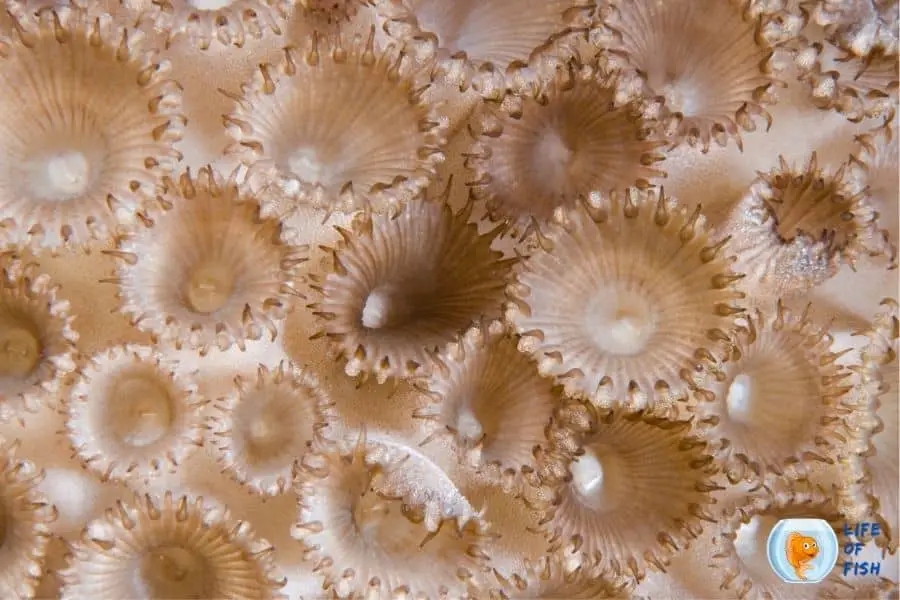Palythoa Coral species add brilliant color to the reef tanks. Therefore, many coral-keeping hobbyists love to keep them, including me. So, through this article, I am going to share my experience with palythoas species. Palythoa corals are commonly known as Moon polyps, Sea mats, Encrusting anemones, Button polyps, and Zoanthid button polyps. They can be found all over the world and mainly inhabit coral reef areas. But mainly palythoa corals collect from the islands located in the Indo pacific region, including Tonga, Solomon Islands, Fiji, and the great barrier reef.

The palythoa corals are a large group in the reef world. Hence, they can decorate your reef tank with a fantastic range of colors and patterns. Also, this variety is pretty easy to care. Because of these reasons palythoa corals are popular among reef-keeping aquarists, even beginners. Moreover, palythoa corals have the ability to tolerate a wide range of water parameters and lighting conditions. Palythoas are omnivores. They are the least aggressive coral variety and grow fast. Therefore, you should provide enough space for them in your saltwater tank.
One Look Care Guide
Jump To
- 1 One Look Care Guide
- 2 The Appearance Of Palythoa Corals
- 3 Zoanthids And Palythoas
- 4 Palythoa Varieties
- 5 Tank Requirements
- 6 How To Place Palythoa Corals In A Tank
- 7 How They Reproduce
- 8 Sexual Difference Of The Palythoas
- 9 How Do Fast Palythoa Corals Grow?
- 10 What Do Palythoa Eat?
- 11 Predators Of Palythoa
- 12 Tankmates For Your Palythoas
- 13 Is Palythoas Dangerous?
- 14 How much Cost of the Palythoas
- 15 Conclusion
| Scientific name | Palythoas sp. |
| Common name | Moon polyps Sea mats Encrusting anemone Button polyps Zoanthid button polyps |
| Care level | Easy |
| Reef Compatible | Reef safe |
| Native to | Islands located in the Indo pacific Tonga Solomon Islands Fiji The great barrier reef |
| Type (soft or hard coral) | Soft |
| Color | Creamy Brown White Coffee Fluorescent |
| Tank size | Minimum 10 gallons (38L) tank |
| Preferred temperature | 72 to 83 Fahrenheit |
| Other water parameters | pH level: 8.1 to 8.4 Alkalinity: 3.2 to 4.8 MEQ/L (8 to 11 dKH) Magnesium: 1250 to 1300 ppm Calcium: 380 to 430 ppm Phosphate: zero (0 ppm) Ammonia: zero (0 ppm) Nitrate: zero (0 ppm) Nitrite: zero (0 ppm) Strontium – 8 to 10 ppm |
| Preferred salinity | 1.023 to 1.025 specific gravity |
| Size | Size can vary with the variety of Palythoa |
| Growth rate | Fast-growing |
| Temperament | Least aggressive |
| Recommended tank mates | Small peaceful corals Reef-safe fish species Reef safe shrimps Hermit crabs Small tangs Blennies |
| Preferred food | Marine algae: Zooxanthellae Baby brine shrimps Freeze-dried plankton |
| Feeding frequency | 2 to 3 times per week |
| Propagation | Can propagate in captivity |
The Appearance Of Palythoa Corals
Palythoa corals have a wide range of color combinations with patterns. However, the most common colors are cream, coffee, brown, and white. Also, fluorescent colors are available in Palythoa corals. But this type is rare to find. The body of palythoa corals or moon polyps is soft and covered with leathery skin. Also, it is called the cuticle and this protects them.
Moreover, the polyps of palythoa corals are short and these polyps are embedded in the mat partially. This connection of mat and polyp is known as coenenchyme. Further, each polyp has a broad, flat oral disc rimmed with its tentacles. When considering palythoa corals’ appearance, they grow in a convex shape. palythoa’s head size ranges from half inches to two inches. But, each colony of palythoa corals can spread up to 4 to 12 inches (10-30 cm).

Zoanthids And Palythoas
When considering zoanthids and palythoas, they are very similar to corals. The below details will help you to identify their similarities and differences clearly.
Similarities Of The Zoanthids And Palythoas
Both zoanthids and Palythoas are colonial-type corals. It means both corals form colonies of individual polyps. Thus, they live together. But, both varieties are semi-aggressive. Further, both varieties are hardy. So, you can keep it easily in your reef aquarium. Moreover, zoanthids and palythoas are soft corals, and they can survive in a wide range of water parameters. In addition to the above factors, these species can tolerate a range of lighting conditions. But they are difficult to tolerate at a high level of water flow. Thus, you can keep both of the corals in the same water conditions in captivity.
Difference between Zoanthids and Palythoas
| Zoanthids | Palythoas |
|---|---|
| Zoanthids come in brighter colors like orange, Blue, Turquoise, and Green. | The majority of Palythoa varieties have slightly dull colors. But do not confuse if you see them with bright colors. |
| Comparatively, Zoanthids have smaller oral disks than Palythoas. | The oral disk of Palythoa is larger than Zoanthids. |
| The tentacles of Zoanthids are smaller and shorter. | The majority of Palythoas’ tentacles are longer than Zoanthids. But few varieties have short and small tentacles. |
| When zoanthid’s rings open, you can see a sphincter in an oral disc of Zoanthids. | But this sphincter is lacking and appears in the oral disk of Palythoa. Instead, it looks more like a slit. |
| Zoanthid coral does not incorporate the tank’s substrate into its skin. | Palythoa corals incorporate the substrate of the tank into their skin. Through this, they enhance the protection. Here you can find tiny dots of your tank’s substrate such as sands and crushed shells on the skin of your Palythoa corals. |
| The tissues of Zoanthids can tear. As a result, the skin of Zoanthid coral is more delicate and thinner. | They have a rougher and thicker appearance. |
| Zoanthid coral does no more likely to grow in the dome-like formation | Palythoa corals prefer to grow in dome-like formations. |
| Zoanthid corals are a bit picky. But they are not aggressive feeders like Palythoas. Also, they do not show more reactions to most foods. | Palythoas are aggressive feeders |
Palythoa Varieties
This coral variety is abundant in the Atlantic Ocean, and because of that, it is known as an Atlantic species. This variety is available in tan, white, and coffee color. Moreover, the polyps of this variety are closely packed. Thus, they touch other polyps. Generally, some polyps in the colony remain open, and some polyps are closed.
During a single day, the colony of this Palythoa type grows around 4 mm, and within a month, they can grow up to 120 mm. Further, this poly is quickly overgrown in captivity too. You can find p.caribaeorumin in shallow water areas with intense lighting conditions with strong water flow in the wild.
Palythoa mamillosa
P. mamillosa is an Atlantic species. Their color range runs from golden brown to yellow. Moreover, this variety has a large oral disk, and its tentacles are small and round. In addition, these polyps can create colonies up to 15cm, and they are maintaining plenty of space between each other. Also, they are happy to live under intense lighting conditions with strong water currents. Thus they are commonly found in shallow areas of the ocean.
Palythoa caesia

Palythoa caesia is a Pacific species, and they have a range of body colors. In the wild, dark brown, tan, or white colors are commonly found. Generally, this variety maintains a space between them, and these colonies do not exceed 10 cm. But rarely find exceptions. Moreover, you can find Palythoa caesia species in shallow water on reef crests and sub tides areas. In the wild, they also like to live under intense lighting conditions with a strong flow rate.
Palythoa psammophila
This is also a Pacific species. It means. psammophila is abundant in the pacific region of the ocean. Further, their color ranges from light brown to green. Also, their oral disk has radiating fine lines. Moreover, they tend to bury in the sand partially and well glow under actinic conditions. Also, they can survive in moderate lighting conditions and flow rates.
Palythoa tuberculosa

Palythoa tuberculosa is also a Pacific species, and its color is light chocolate. They have a honeycomb pattern. During the daytime, most of their polyps remain close. Thus, they open and take their diet at night. In the wild, you can find them in many habitats which have shallow to deep water. In addition to these varieties, there are so many varieties of Palythoas species. Some of these are:
- Palythoa senegambiensis
- Palythoa stephensoni
- Palythoa shackletoni
- Palythoa sinensis
- Palythoa singaporensis
- Palythoa howesii
- Palythoa tropica
- Palythoa tropica
- Palythoa texaensis
- Palythoa variabilis
Therefore, you can rear the above species in your reef aquarium.
Tank Requirements
Even though Palythoas can survive within a wide range of water conditions, you have the responsibility to look after them. So here I include their requirements.
Size Of The Tank
You can rear Palythoas in a 10 gallons (38L) tank. But it is better to keep them in a large tank rather than a Nano tank.
Water Quality
The ideal water parameters are mentioned below.
| Water region | All areas of the aquarium |
| Calcium | 380 to 430 ppm |
| Alkalinity | 3.2 to 4.8 MEQ/L (8 to 11 dKH) |
| Phosphate | 0 ppm (zero) |
| Magnesium | 1250 to 1300 ppm |
| Strontium | 8 to 10 |
| Salinity | 1.023 to 1.025 specific gravity |
| Temperature | 72 to 83 Fahrenheit |
| pH level | 8.1 to 8.4 |
| Nitrates | 0 ppm (zero) |
| Nitrites | 0 ppm (zero) |
| Ammonia | 0 ppm (zero) |
Special note: You should maintain a stable tank condition for Palythoas. Therefore, you should perform a 20% water change per month or a 10% water change every two weeks. Also, the 5% of water change per week is the best practice.
Further, you should make sure that iodine is available in the aquarium water.
Flow Rate
Palythoa corals can live at moderate to high water flow rates. So, if you provide a preferable water flow, they will perform well. But, the too high flow rate is a barrier to opening the polyps.
Lighting
Palythoas can live in a wide range of lighting conditions. Also, they can tolerate low and high lighting conditions. Thus, the recommended lighting condition is low to moderate. Further, you should acclimate newcomers under low lighting conditions because high lighting conditions can be a risk.
Low light rate: 30 to 50 PAR
Medium rate: 50 to 150 PAR
High rate: over 150 PAR
PAR: Photosynthetically Active Radiation
Special notes: Palythoa corals have zooxanthellae inside their body. Therefore, they can produce foods under tank lighting conditions by using zooxanthellae. Also, these corals can get the additional required nutrients from the water in the tank.
How To Place Palythoa Corals In A Tank
Do not try to place Palythoa corals in the reef aquarium as soon as you purchase them. Thus, they do need some time to adapt to the new environment. Therefore, acclimating process will help you to accomplish this challenge. You have to collect the following equipment:
- Plastic cup
- Net
- Clean empty bucket
- Newly prepared saltwater that has the same temperature as the main aquarium
- Thermometer
step 1: Firstly, turn off the light in your main aquarium and dim the lights in the room
step 2: Secondly, unwind the coral package and remove its water to the empty bucket. Then carefully add your coral into this bucket.
Impotent: Be careful when you handle the Palythoa corals. Do not touch them without wearing gloves.
step 3: Slowly add one cup of water from the main aquarium into the bucket
Step 4: Repeat step 3 continuously every 5 minutes for 45 minutes
Step 5: Carefully remove the Palythoa coral from the bucket
Step 6: Place them in a safe and suitable place in your main aquarium
Important: The area should have low-medium to medium-high flow. Also, low to moderate lighting conditions are better.
Step 7: Then, discard the water in the acclimation bucket
Step 8: After that, refill the water removed from the main aquarium from the newly prepared saltwater
Step 9: Finally, Keep the low lighting condition and gradually enhance it up to the preferable level
Step 10: Slowly do this by giving them time to adapt to the new environment.
Also Read: Moon Jellyfish Care Guide | Everything To Know | Exotic Pets
Also Read: Sand Sifting Goby Care Guide | Exotic Pets| Everything To Know |
How They Reproduce
Generally, Palythoa corals are reproduced by forming and budding off new polyps from the mat. However, since their propagation process is simple, you can propagate them in captivity. Tools that need to start the propagation process:
- Bone cutter
- Scissor
- Scalpel
- Small bucket
Step 1: Firstly, separate the few Palythoa corals from the large colony and put them into the bucket
Step 2: Then, break up the substrate from the Palythoas
Step 3: Cut the mat or chip of Palythoa under the polyp’s grip into small pieces
Step 4: After that, keep the small pieces on the paper towel to soak up excess water
Note: Palythoa corals can be resistant to atmosphere exposure
Step 5: Then, take a rock, frag disk, or frag plug to attach the new Palythoas. Take a rock, frag disk, or frag plug to attach the new Palythoas.
Rock: Select a rock, if you want to propagate them and keep them in your aquarium
Frag disk: Select frag disk, if you plant to frag later and grow large colonies
Frag plug: Select a frag plug if you want to grow colonies and sell them soon.
Step 6: Using superglue (gel is the best option), attach the small pieces to the frag disks
Step 7: Give a few seconds to fix them properly
Step 8: Finally, put them into the water.
Make sure the preferable conditions consist of the particular tank.
Special Note: You should highly consider your safety. There are varieties of Palythoa corals containing very harmful and powerful neurotoxins in their flesh, namely palytoxin. Further, this species can survive out of the water for a few minutes without any effect.
Sexual Difference Of The Palythoas
The sexual difference cannot be identified by examining their physical appearance because every polyp look like same. Thus, if you need to identify their sex difference, you should know their inner body and its functions.
How Do Fast Palythoa Corals Grow?
Generally, Palythoa corals are faster-growing species. However, if they are happy with the lighting and water flow, you can experience this. There are some varieties of Palythoa, that can grow colonies around 4 mm wide within a day. Also, they can grow up 120mm wide within a month. Therefore, this poly can be overgrown quickly.
What Do Palythoa Eat?
The wild palythoa mainly eat marine algae, dissolved organic matter, planktonic organisms, and microscopic food particles in the water column. In captivity, they prefer to eat baby brine shrimps, freeze-dried plankton, and marine algae.
How To Feed Palythoa?
They cannot consume large food particles. Thus, you should chop the food or cut it into tiny pieces. If you choose frozen foods to feed, thaw them out before adding them. Further, you can spray or sprinkle liquid food right over the polyp of the coral using the Turkey Baster tool. Then, palythoa will slurp the food themselves.
Special Notes:
Food is the main source to enhance and keep coral color, growth, and health. But, do not overfeed. Instead, you can add a small amount of feed at once. Additionally, be sure your filtration system can handle the foodstuff. Because some types of Palythoas corals avoid feeding, and some are fast and aggressively eat feeds.
Feeding Frequency Of Palythoa?
You can feed the palythoas species two to three times a week. It will help them to collect the required nutrients from the water.
After feeding
It would be best to filter out or remove the uneaten food particles from the reef tank because uneaten foods can reduce water quality by releasing the by-products such as ammonia, nitrate, and nitrites. These can affect your marine creatures, including corals and fish species. Further, it can damage the beauty of the reef tank too.
Predators Of Palythoa
Zoanthid Spiders
Zoanthid Spiders are the main predator of Palythoa. Their size is 0.5 cm to 1 cm. Also, zoanthid spiders look like household spiders. But they are light brown. You can remove them physically by using a tweezer. To protect the Palythoas from Zoanthid Spiders, you should check the corals at least once a month.
Other Predators
- Polychaete worms (Hermodice carunculate)
- Crown of throns Starfish (Acanthaster planci)
- Chaetodon species
- Large crustaceans
- Large angelfish
- Butterflyfish
- Sea anemones
- Tube anemones
- Sea slug from the Aeolidiopsis genus
Tankmates For Your Palythoas
These are the ideal tankmates that can peacefully live with palythoas species. Thus, you can decorate your reef aquarium by mixing corals and live creatures that mention below.
- Small peaceful corals
- Reef-safe fish species
- Reef safe shrimps
- Hermit crabs
- Small tangs
- Blennies
Is Palythoas Dangerous?
Yes, most of the Palythoa genus produce high levels of poison, namely Palytoxin. Also, the different Palythoas varieties contain different degrees of this poison. Moreover, palytoxin is made in the mucus and gonads of the Palythoa corals. Primarily this toxin enters the body through open wounds. Also, this toxin can enter the bloodstream of people. Therefore you should be careful when using palythoas coral in your home aquarium.
Additionally, you can reduce this risk by following proper precautions. You can wear an appropriate pair of gloves and goggles before handling the Palythoas. Further, after handling the Palythoas, make sure the mucus is not available on your gloves. If you have a wound on your hand, it is better to avoid handling corals or postpone it until the wound is healed.
Important Facts:
The filefish eat palythoa polyps as a diet. Then, they bring this palytoxin into the food chain. So, if anyone consumes filefish as food, it will be toxic to them. Further, pacific tribes use this toxin as a weapon. They coat spears with the mucus of Palythoas and use these spears to paralyze their enemies and prey animals.
Why Are Palythoa Dying?
There are some reasons for palythoas deaths in captivity. These are:
Acclimation issues
In this situation, they will stress due to the new environment. If you do not find a solution, it can be ended with the death of Palythoas polyps. Thus, you should apply the correct acclimate process to them.
Poor water quality
The palythoas species can survive in a wide range of water quality parameters. But you should maintain a good environment in the tank. Also, keep your eye on the nitrate, nitrite, ammonia, and phosphate levels in your water. They can harm the Palythoas. Further, you should install a proper filter system to reduce those parameters to zero levels.
Too high or too low lighting conditions
They can collect more required nutrients under proper lighting conditions. Therefore, you should provide a recommended level of lightning to encourage them to grab the feed.
The too-high flow rate of water causes the death of the Palythoas.
Moreover, palythoas are unable to open their polyps properly under a high flow rate. As a result of this, palythoas can not grab enough food from the environment. Finally, It will directly affect their health too.
How much Cost of the Palythoas
The price of the palythoas ranges between $6 to $100. However, this value can be varied with the size and variety of the Palythoas. Further, shipping costs also change the amount of the polythos corals.
Conclusion
The vibrant color reef aquarium is a dream of every saltwater fish hobbyist. Hence, palythoas coral is an excellent selection for your home aquarium because of its eye-catching, beautiful colors. Thus, I would like to welcome you all to rear Palythoas with my guidelines. To be sure, your corals live longer with good practices and care.
Also Read: Rose Bubble Tip Anemone | Beginners To Expert Care Guide |
